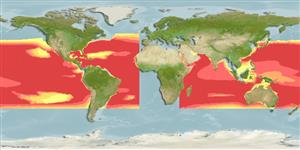>
Beryciformes (Sawbellies) >
Cetomimidae (Flabby whalefishes)
Etymology: Cetostoma: Greek, ketos = a marine monster, whale + Greek, stoma = mouth (Ref. 45335).
Environment: milieu / climate zone / depth range / distribution range
Écologie
marin bathypélagique; profondeur 0 - 2250 m (Ref. 6715). Deep-water; 50°N - 40°S, 35°E - 13°W
Atlantic Ocean: between 50°N to 40°S; one specimen was recorded at 30°45'N, 25°47'W (Ref. 6715) and 8 specimens from 28°N, 16°E. Indian Ocean: between15°N and 31°S. Pacific Ocean: between 45°N and 15°S, and off central California, USA.
Taille / Poids / Âge
Maturity: Lm ? range ? - ? cm
Max length : 24.7 cm SL mâle / non sexé; (Ref. 9791)
Épines dorsales (Total) : 0; Rayons mous dorsaux (Total) : 29 - 37; Épines anales: 0; Rayons mous anaux: 26 - 34; Vertèbres: 47 - 53.
Normal diurnal distribution is between 700 and 1200 m The shallowest diurnal capture (500-600 m) is of one of the smallest specimens (4.3 cm) and the deepest (1500-1600 m) is of one of the largest (20.4 cm), indicating a trend for the diurnal depth to increase with increasing size (Ref. 9791). Nocturnal distribution is between 110-700 m (Ref. 9791). Feeds on decapods and euphausiids (Ref. 6715). Minimum depth from Ref. 58018.
Life cycle and mating behavior
Maturities | Reproduction | Spawnings | Egg(s) | Fecundities | Larves
Paxton, J.R. and D.J. Blake, 1990. Cetomimidae. p. 607-608. In J.C. Quero, J.C. Hureau, C. Karrer, A. Post and L. Saldanha (eds.) Check-list of the fishes of the eastern tropical Atlantic (CLOFETA). JNICT, Lisbon; SEI, Paris; and UNESCO, Parisl. Vol. 2. (Ref. 6532)
Statut dans la liste rouge de l'IUCN (Ref. 130435)
Menace pour l'homme
Harmless
Utilisations par l'homme
Outils
Articles particuliers
Télécharger en XML
Sources Internet
Estimates based on models
Preferred temperature (Ref.
123201): 4.9 - 13.9, mean 8.1 °C (based on 1132 cells).
Phylogenetic diversity index (Ref.
82804): PD
50 = 1.0000 [Uniqueness, from 0.5 = low to 2.0 = high].
Bayesian length-weight: a=0.00389 (0.00180 - 0.00842), b=3.12 (2.94 - 3.30), in cm total length, based on all LWR estimates for this body shape (Ref.
93245).
Niveau trophique (Ref.
69278): 3.4 ±0.45 se; based on food items.
Generation time: 1.6 ( na - na) years. Estimated as median ln(3)/K based on 1
growth studies.
Résilience (Ref.
120179): Milieu, temps minimum de doublement de population : 1,4 à 4,4 années (Assuming tmax>3).
Fishing Vulnerability (Ref.
59153): Low vulnerability (22 of 100).
